I never make french fries at home, in part because the chefs above have related just how complicated it is to make a really good fry (it can be a two-day process,) but since we had Dr. Lasergonopus with us for an afternoon, I thought I'd take a stab at it.
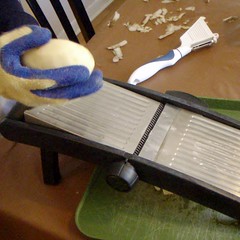 First, potatoes. All great french fries start with a starchy potato, so even if you have waxy red potatoes on hand - go buy yourself some russets. While I do like fries with some peel, we went old-school and peeled our potatoes, and then sliced them on our mandoline's julienne blade. (Kevlar gloves are a great tool to protect your hands when using a mandolin slicer.)
First, potatoes. All great french fries start with a starchy potato, so even if you have waxy red potatoes on hand - go buy yourself some russets. While I do like fries with some peel, we went old-school and peeled our potatoes, and then sliced them on our mandoline's julienne blade. (Kevlar gloves are a great tool to protect your hands when using a mandolin slicer.) Second, once the potatoes are cut to your satisfaction, a soak to remove the outside layer of starch. This step is pretty simple, but critical: as you're cutting, occasionally stop and dump the cut fries into a container of plain water. Some of the starch will leach out into the water, making it cloudy but leaving the correct balance of pectins, starches and sugars in your fry.
Second, once the potatoes are cut to your satisfaction, a soak to remove the outside layer of starch. This step is pretty simple, but critical: as you're cutting, occasionally stop and dump the cut fries into a container of plain water. Some of the starch will leach out into the water, making it cloudy but leaving the correct balance of pectins, starches and sugars in your fry.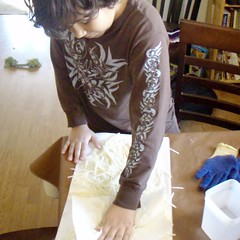 Third, the fries must be dried thoroughly to help them stay crispy and to help maintain the temperature of the hot oil as much as possible. After draining off the starchy water, Dr. Lasergonapus dried them on several layers of paper towels.
Third, the fries must be dried thoroughly to help them stay crispy and to help maintain the temperature of the hot oil as much as possible. After draining off the starchy water, Dr. Lasergonapus dried them on several layers of paper towels.At this point, you can start thinking about frying (see why I don't do this at home very often?) You need to set up three stations in the following order:
- A cookie sheet with a baker's cooling rack over the top of it, where your fries will drain and cool slightly after the blanching stage (think of it as a potato nap station.)
- A heavy, large dutch oven (I recommend enameled cast iron) or similar pot with enough oil, at minimum, to fill it 1 1/2 inches deep, set over your favorite burner on your stove. MAKE SURE it has a tight-fitting lid and is considerably deeper than the volume of what will go in it, to prevent boilovers of oil. I admit - I used a combination of canola oil and rendered fat saved from cooking (i.e. my french fries are NOT vegetarian, but they taste good.)
- A large serving dish lined with several layers of paper towels, the final destination for completed french fries (please make sure it's not close enough to your burner to catch fire.)
Bring the oil in the pot up to 350 degrees, or hot enough that a drop of water instantly fizzles to nothing (If you use this method of testing, use only ONE small drop, and step back as you drop it in.)
 Using tongs, we gently laid the fries into the hot oil in a single layer (we made the fries in about four batches.) and allow to cook until they become limp like wet noodles, but still pretty much retain their raw color. Immediately remove them with the spider, draining off excess oil, to your "potato nap" station and repeat until all your fries are "napping."
Using tongs, we gently laid the fries into the hot oil in a single layer (we made the fries in about four batches.) and allow to cook until they become limp like wet noodles, but still pretty much retain their raw color. Immediately remove them with the spider, draining off excess oil, to your "potato nap" station and repeat until all your fries are "napping."Allow the oil in the pot to heat back up to 350 degrees (the "nap" should take at least two minutes for this reason.)
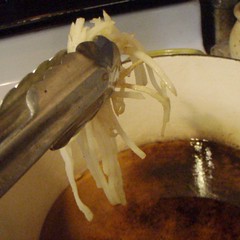 Again, using your tongs to gently lay the fries into the hot oil in a single layer, put your once-cooked, "napped" fries back into the hot oil (see how floppy and white they are before the second cooking?) and fry until they are crispy, golden-brown, and look good enough to eat.
Again, using your tongs to gently lay the fries into the hot oil in a single layer, put your once-cooked, "napped" fries back into the hot oil (see how floppy and white they are before the second cooking?) and fry until they are crispy, golden-brown, and look good enough to eat.  For tender fries, pull them just after they start to color and still "flop" slightly, as pictured. For extra crispy fries, leave them in until they're rigid. Using your spider, fish out the fries and lay them on the towels in your final destination. As soon as you're done, turn off the burner.
For tender fries, pull them just after they start to color and still "flop" slightly, as pictured. For extra crispy fries, leave them in until they're rigid. Using your spider, fish out the fries and lay them on the towels in your final destination. As soon as you're done, turn off the burner.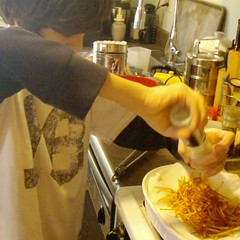 Salt immediately while the fries are still hot (do not attempt to eat immediately, let them cool slightly. You can keep your serving dish warm in a 200 degree oven for a few minutes if you're concerned they will cool too much while you make your aioli.)
Salt immediately while the fries are still hot (do not attempt to eat immediately, let them cool slightly. You can keep your serving dish warm in a 200 degree oven for a few minutes if you're concerned they will cool too much while you make your aioli.)Now, for the "aioli" dipping sauce:
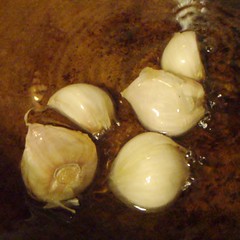 Allow your oil to cool slightly; turn your burner to medium heat. Put 5-8 unpeeled cloves of garlic into the hot oil, and fry on medium heat for about five minutes until the paper splits and the garlic gives gently when squeezed with tongs.
Allow your oil to cool slightly; turn your burner to medium heat. Put 5-8 unpeeled cloves of garlic into the hot oil, and fry on medium heat for about five minutes until the paper splits and the garlic gives gently when squeezed with tongs. 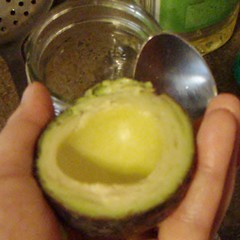 Remove, drain, cool lightly and peel; the garlic should now be soft and extremely mellow in flavor. Place the garlic cloves in a blender jar or food processor with half an avocado, about a tablespoon of olive oil, and about 1/4 teaspoon of salt.
Remove, drain, cool lightly and peel; the garlic should now be soft and extremely mellow in flavor. Place the garlic cloves in a blender jar or food processor with half an avocado, about a tablespoon of olive oil, and about 1/4 teaspoon of salt.Blend into a rich puree, adding olive oil as needed to bring it to the consistency of mayonnaise. Scrape out every last bit with a spatula into a serving dish; serve with a sprinkle of paprika and scoop it up with your excellent shoestring fries!
Should you eat french fries every day? Probably not. Would you eat french fries every day if you had to save a block of time sufficient to make this recipe, follow all those steps, and then clean up the crazy volume of dishes? Probably not, either.
Was it totally worth it this time? Heck yea!
Enjoy!
PS. Shout-out to CNN's ireport for their coverage of one of our Pi Day pies, and don't forget to check here for:

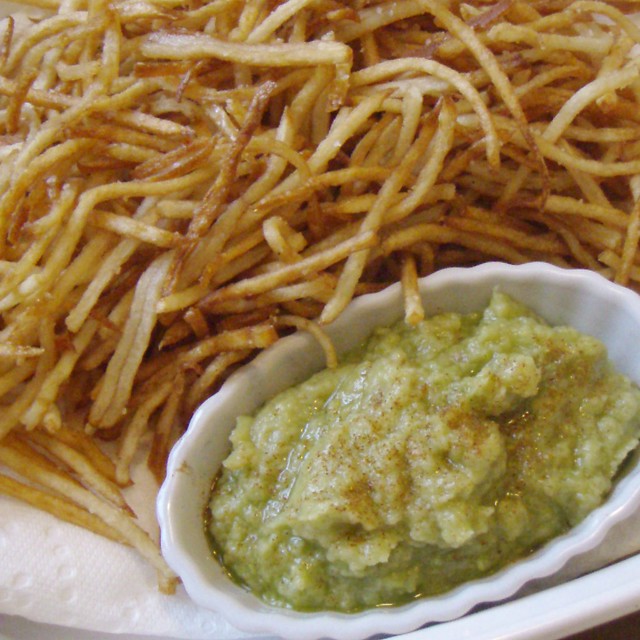
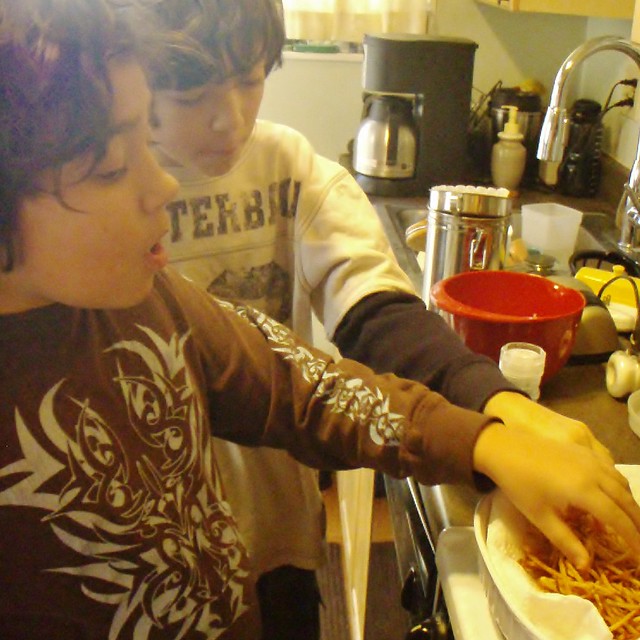




No comments:
Post a Comment